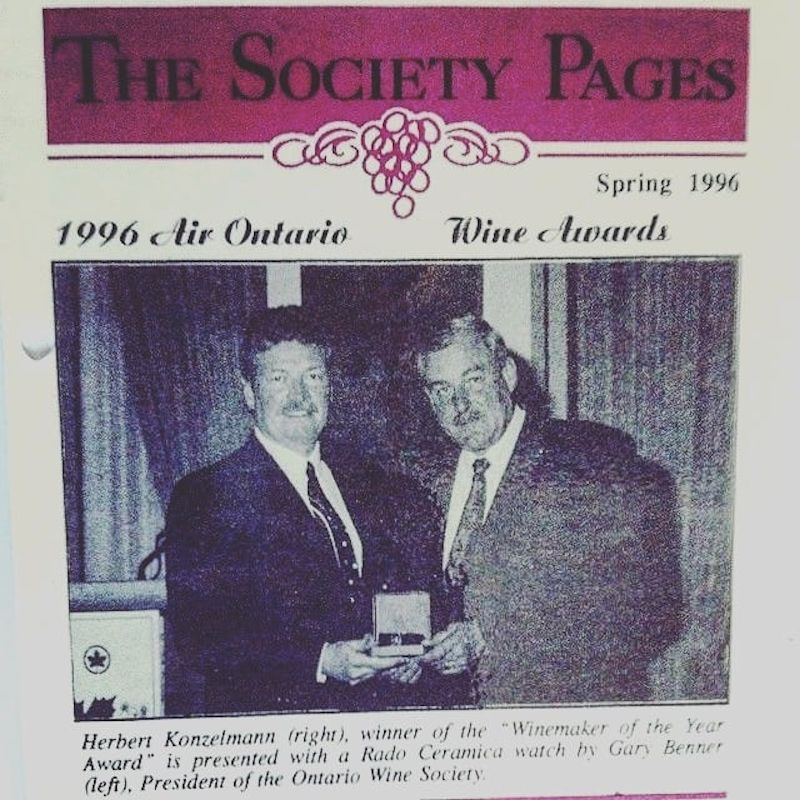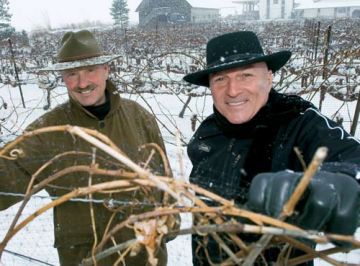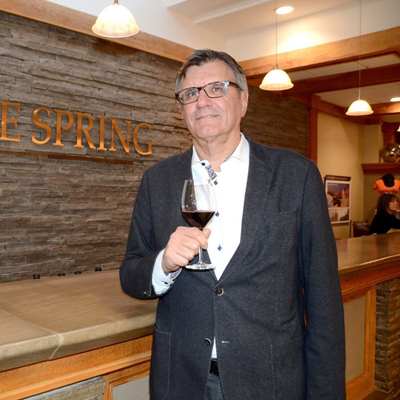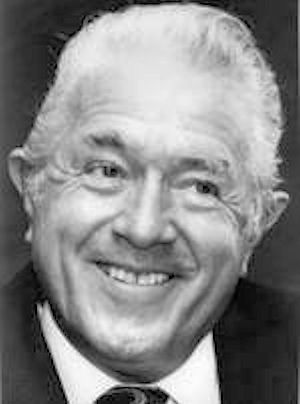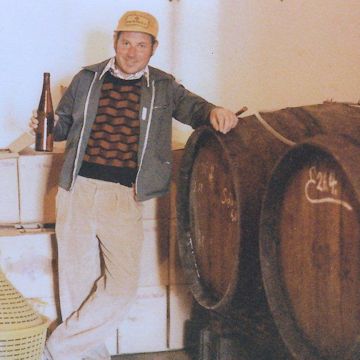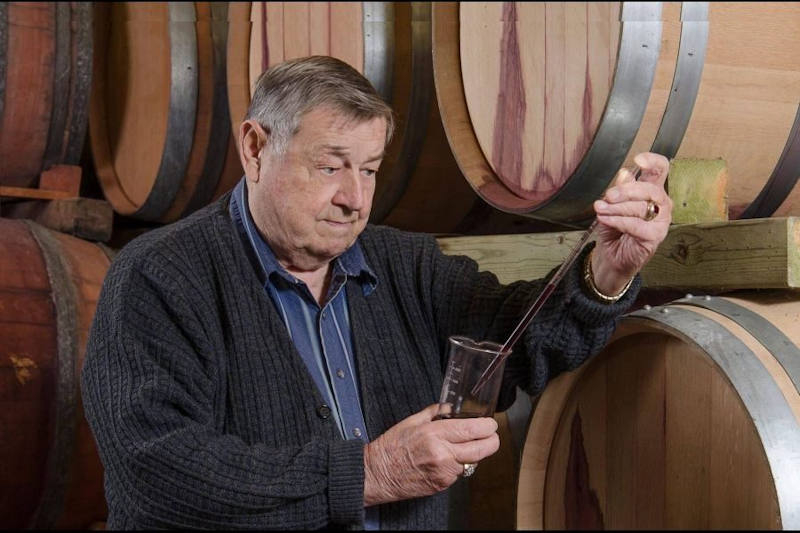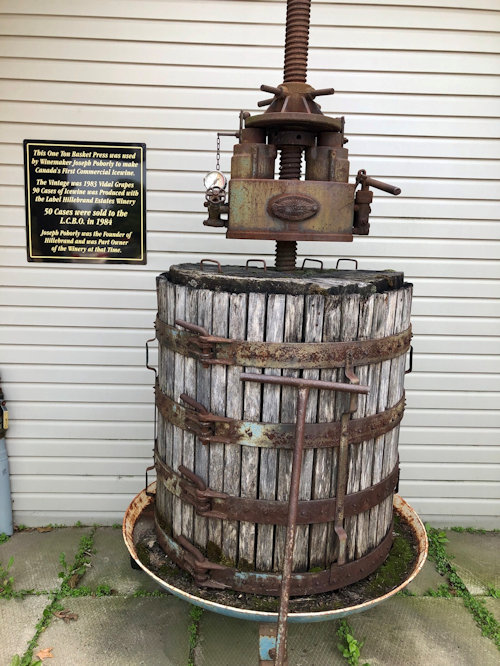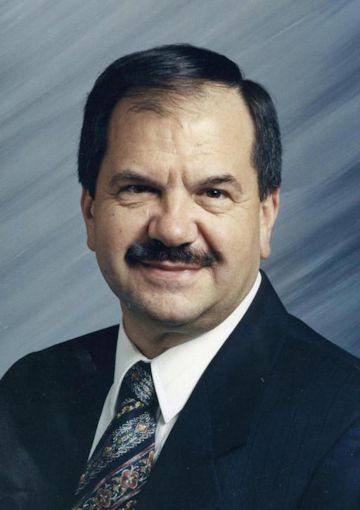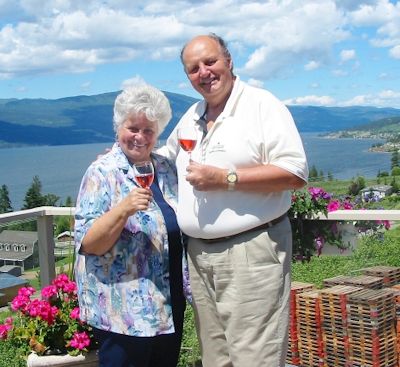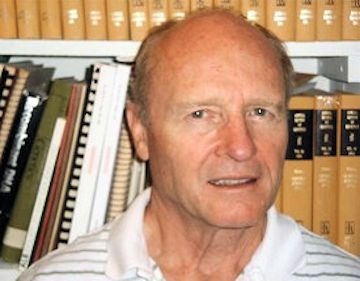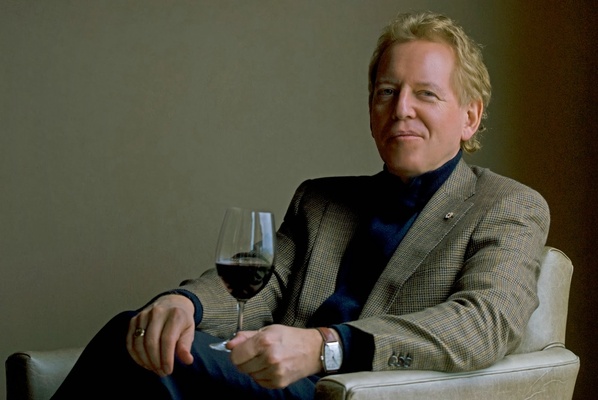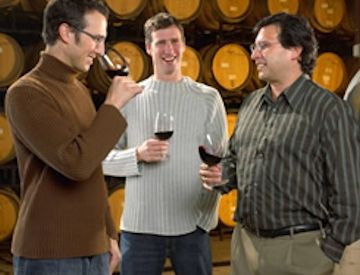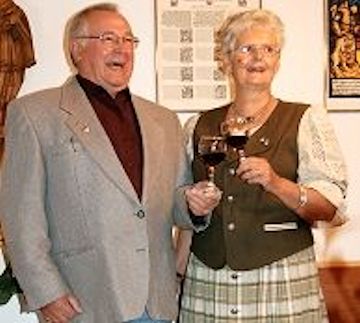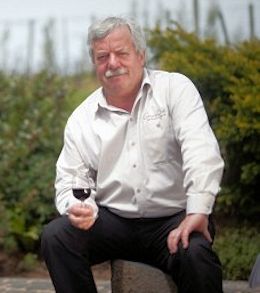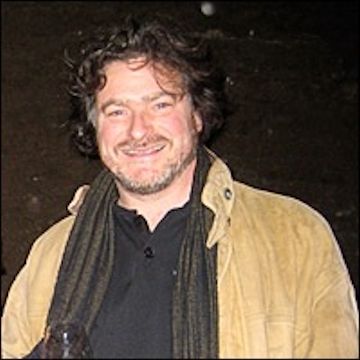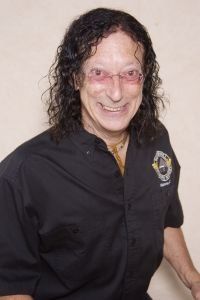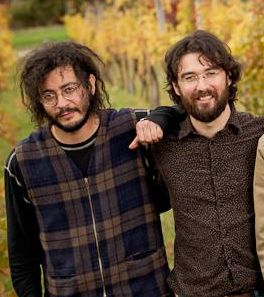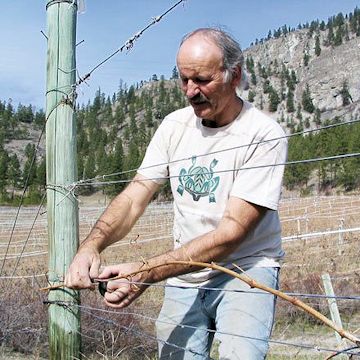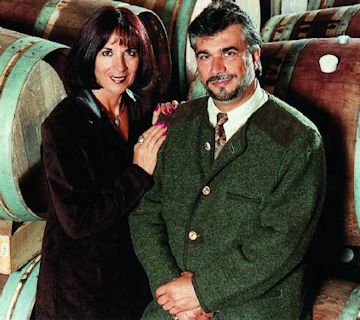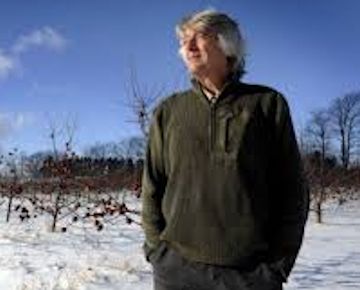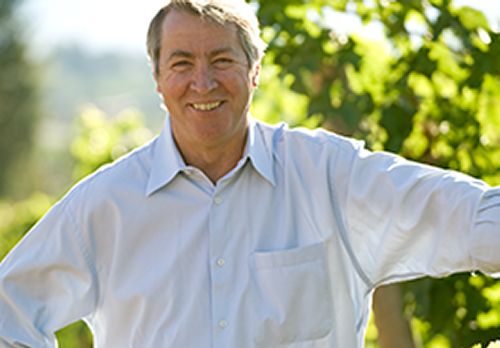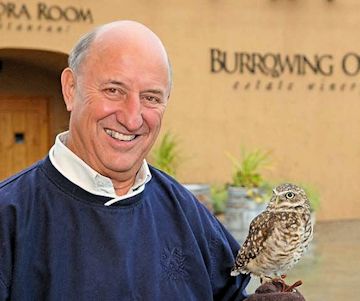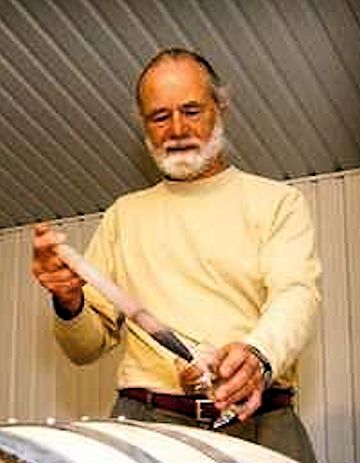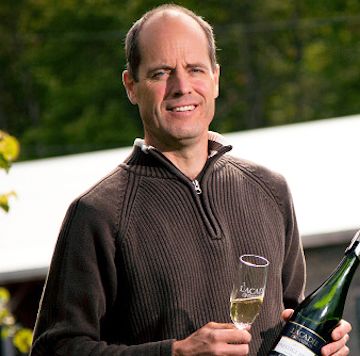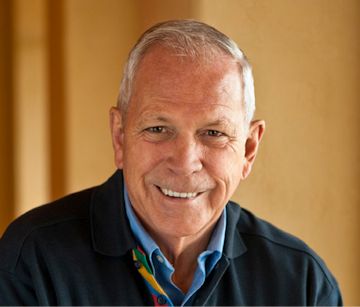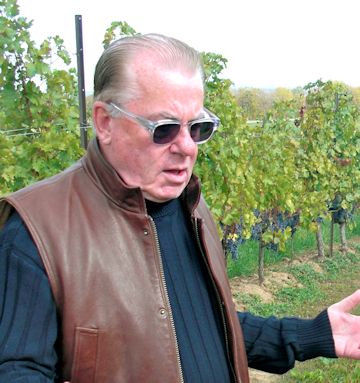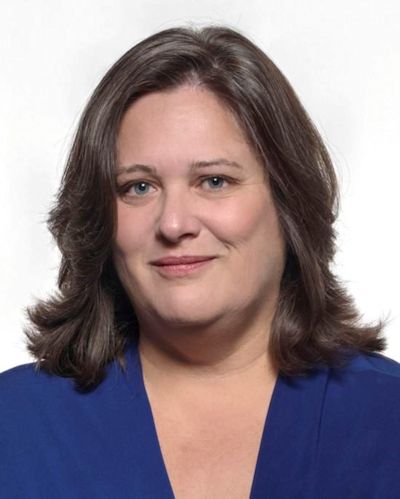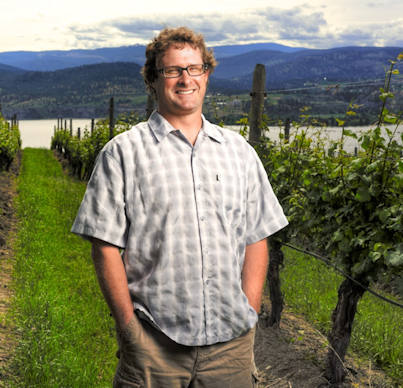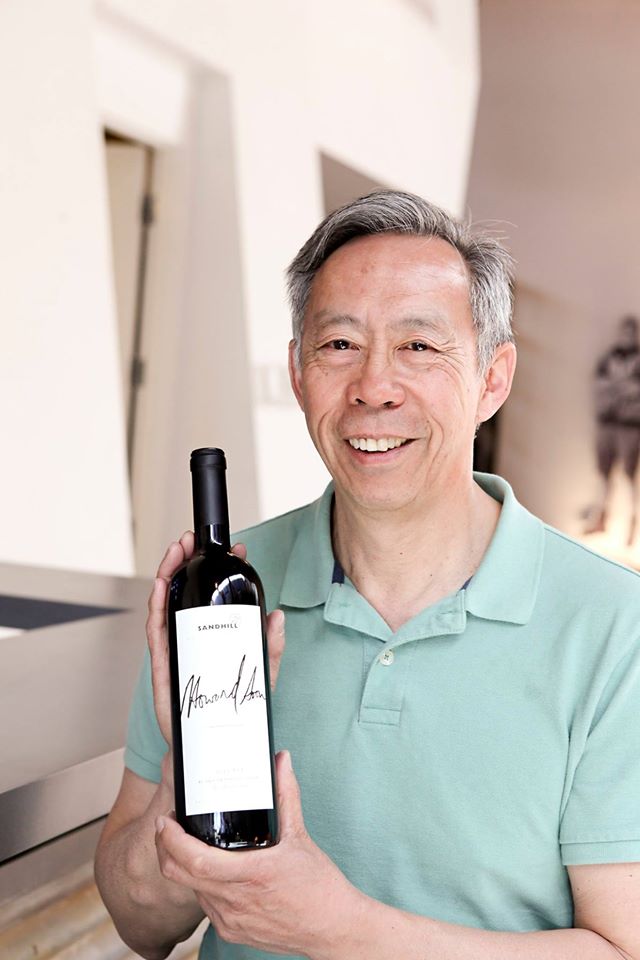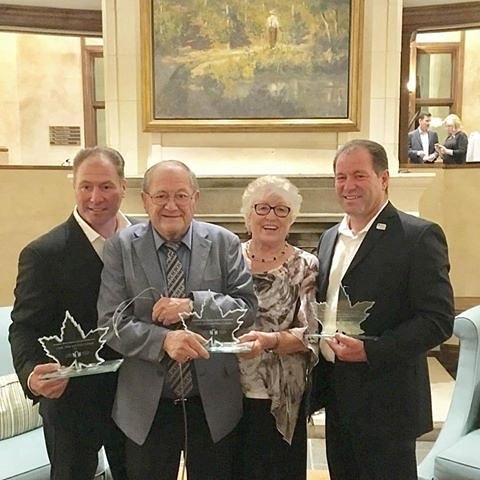Robert Bell's
Wines of Canada
Since 1992
The Giants of the Modern ERA
The Names Behind Winemaking in Canada
A work in Progress
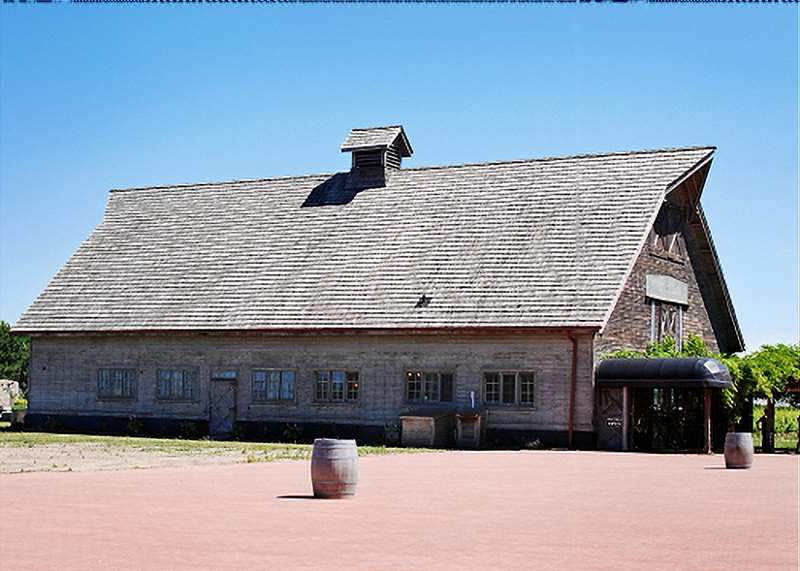
Brae Burn Barn at Inniskillin Winery
The question is when did the modern Era Start! Some say it began with Donald Ziraldo and Karl Kaiser co-founders of Inniskillin (1974). Other will say it was the 90's when wine product in Canada saw rapid growth and almost every winery produced world class wines.
Another question is when did the Candian wine Industry really begin. Wine in Canada can be traced back to the Vikings. Commercial wineries to the 1870's. Very little information about the late 1800's and early 1900's is hard to find. Maybe the Modern Era begins with the internet.
Maybe it should be based upon sales when did Canadians start buying domestic wines and less imported wines?
Herbert Konzelmann was awarded as the first ever Winemaker of the Year from the Ontario Wine Awards
almost 25 years ago!
Recently, Herbert was awarded for Lifetime Achievement from the Ontario Wine Awards to honour his 30+ years as a pioneer of the Niagara Wine Industry!
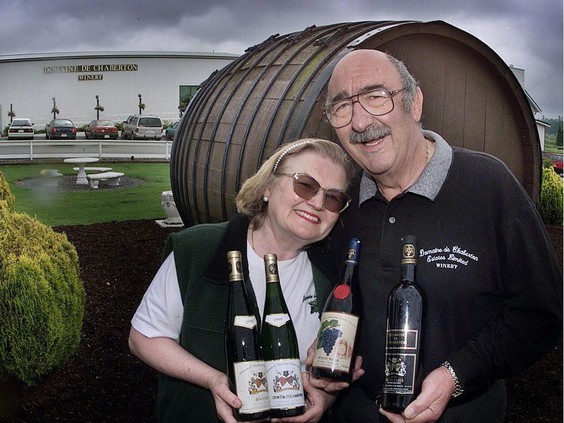
Inge and Claude Violet opened the Domaine de Chaberton Estate Winery 1975
The first winery in the Fraser Valley of BC
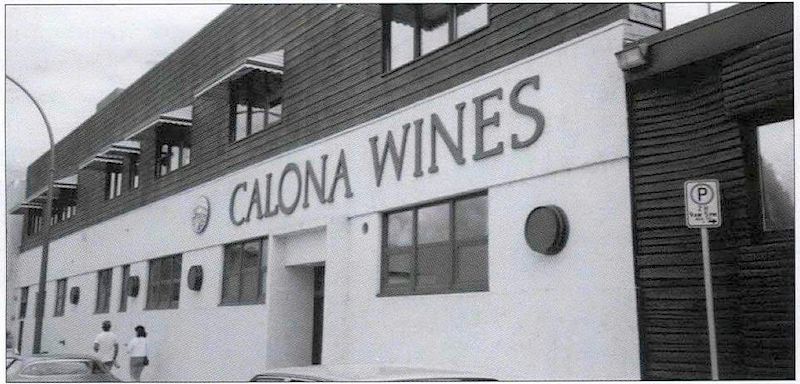
In 1977 Calona Wines released Schloss Laderheim made from Okanagan Riesling. It became the best selling domestic wine. The winery began in 1931. Today Calona is owned by Andrew Peller Limited
Dr. Joseph Peller, Andre Peller's son, joined Andrés in 1965 and subsequently took over as President & CEO in 1970. In 1989, third generation John E. Peller joined the company as Vice President Sales & Market Planning. In 1993, Dr. Joseph Peller relinquished his Presidency and in 1995, his position as CEO to his son John.
The winner of the Canadian Wine Industry Award of Distinction 2019 - regarded as the highest form of peer recognition in the Canadian wine industry – is Dr. Joseph Andrew Peller and Family. Dr. Peller dedicated 30 years of his adult life to developing Canada's first truly national wine brand, helping develop the wine growing regions in British Columbia, Central and Atlantic Canada. CEO of Andrés Wines (now Andrew Peller Limited) from 1965 until 1995, he displayed exceptional leadership and was an inspiration to his employees, whom he always endeavoured to treat like family. Andrew Peller Limited grew and prospered under Dr. Peller’s dedication and leadership.
Joe Busnardo, who currently owns Divino Estate Winery on Vancouver Island, planted the first commercial vineyards on the Golden Mile in 1969. Busnardo was one of the first in the South Okanagan to plant European Vitis Vinifera; he’d brought dozens of varieties to try, including some from his native Italy, like the Trebbiano still used to make Hester Creek’s popular single-varietal white wine released each spring. He built Divino Estate Winery on the site in the early ’80s, which he later sold in 1996. He moved to Vancouver Island and re birth Divino winery.
Donald Ziraldo co-founder Inniskillin (1974) he sold the wines . Through his hard work Icewine became synonymous Canada . More on Donald Ziraldo
Karl Kaiser co-founder Inniskillin (1974) he made the wines. Donald Ziraldo refers to Karl as the mastermind behind the Renaissance in Icewine. More on Karl Kaiser
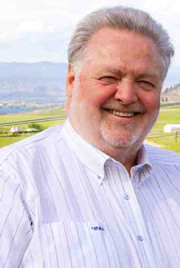
Harry McWatters founded Sumac Ridge 1980 Summerland British Columbia. In 1980, he led a group of wineries and local businesses to establish the Okanagan Wine Festival Society and acted as founding president. Harry McWattersIn 1965 a Okanagan businessman named R.P. "Tiny" Walrod led the development of a California interest along with local investors in starting a winery perched on Mt. Boucherie over looking Okanagan lake. There were two separate companies Mission Hills Vineyard Ltd. and Mission Hills Wines Ltd. They would later consolidate into one public company. Walrod passed away before the winery opened. Poor wine and financial problems caused the winery to fail. In 1970 Ben Ginter takes over the winery renaming it Uncle Ben's Gourmet Wines Ltd. He set about trying to match the hot product of the day Baby Duck He came out with Foddle Duck Yellow bird and Hot Goose. However the winery slipped into receivership in 1978. Ben Ginter managed to find the funds to repurchase the winery changing the name to Golden Valley Wines Ltd. In 1981 he sold the winery to Anthony Von Mandl and Nick Clark.
Hernder’s Estate Winery official opened in 1993 but their history begins long before that. It was Fred Hernder who started it all. Fred purchased the family farm in 1968 outside of St. Catharines, Ontario, and began the acquisition of others. In 1939 his parents moved the family from Germany to the “Grapeview” area of St. Catharines, Ontario, to a mixed fruit farm that included acreage of indigenous grapes.“ His success was heralded when he was crowned as the youngest Niagara “GRAPE KING” in 1977. Forever the entrepreneur, Fred began selling not only grapes & juice, but also winemaking supplies to the growing home market as well as wineries.
Leonard PennachettLeonard Pennachetti n 1973 the Pennachetti family acquired its first farmland at Cave Spring on Beamsville Bench of Ontario. John Sr. and Len worked to establish their vineyard. They focused on planting time-honored European grape varietals, and cultivating these vines with a mixture of traditional and modern techniques. In 1978, the Pennachettis were among the first to plant Riesling and Chardonnay vines on the Niagara Peninsula In 1981, recognizing his passion for Niagara’s promising wine industry, Len built a house on the vineyard. “I saw a chance for getting back to the land and creating a place where our family could do something special,” says Len. “Vineyards exist from generation to generation. . Len’s commitment to quality Riesling production is underscored by his recent appointment to the Board of Directors of the newly formed International Riesling Foundation.
Hans Buchler, One of the leading organic grape growers in the Okanagan, the lean, lanky Buchler farms a seventeen-acre vineyard tucked into a bucolic, pine-covered valley high above Oliver. In Berne, Switzerland, where he was born, his father was a doctor and his mother a teacher. When he finished college, Buchler spent some time traveling before returning to Switzerland and marrying Christine, a nurse. They lived and worked on his father-in-law's organic vegetable farm in the Swiss wine growing region known by the appellation La Cot, where his interest in grapes and wine began. Land prices being prohibitive in Switzerland, Buchler and his wife emigrated, choosing Canada over New Zealand because Buchler had traveled across Canada in 1976. "I was just overwhelmed by the beauty of British Columbia," he recalls. The raw land they purchased near Oliver was planted to grapes in 1983 after Buchler negotiated a contract to sell the fruit to Mission Hill. They originally planted foch, Okanagan Riesling and verdelet, along with only two vinifera (gewurztraminer and white riesling). The Okanagan riesling was the first to be replaced -- with chardonnay, pinot noir and semillon; half of the foch was uprooted later and the verdelet was pulled out after the 1995 harvest, to be replaced by pinot noir and gamay. The remaining foch plants may have gained a lease on life by the return of this variety to favor. As well, Mission Hill has had commercial success marketing an organic foch wine, made from Buchler's grapes.
The vineyard has been organic since 1988, after Buchler had used herbicicides and synthetic fertilizers in the first two years. "But that does not agree with my outlook on farming," he says. Now he gets nutrients into his soils by growing legume cover crops such as peas, vetch and clover, so successfully that some parts of the vineyard are at risk of having excessive nitrogen (which causes the vines to grow too vigorously). Weeds are kept under control with cultivation and by incinerating the young weeds with blasts from a portable propane-fueled flame thrower. The most devastating insect pest in vineyards is the leaf hopper. Buchler has found the populations of these can be reduced with insecticidal soaps and by introducing parasites, some of which are commercially available while others -- notably a microscopic wasp called Anagrus epos -- occur naturally. None of the controls is complete but Buchler is satisfied with establishing a balance between nature and an acceptable amount of damage. "I always have to find the solution which is the least labor intensive," he says.
Dedicated to organic principles, Buchler is a member of the Similkameen-Okanagan Organic Growers Association and has been president of the Association of Certified Organic Growers of British Columbia. With three wineries fully organic in 1995 and with many requests for information from growers, Buchler knows he is no longer pioneering the concept.**
Angelo Pavan partnered with the Pennachetti family 1983 to open Cave Spring Cellars in the picturesque village of Jordan.
Guided by Len and the Pennachetti family, and built on three generations of winemaking tradition in the region, Cave Spring is respected as one of the foremost producers of Riesling in North America, and is widely recognized as one of Canada’s finest wineries.
Wild Goose founder Adolf KrugerAdolf Kruger was one of the most influential pioneers of the British Columbia wine industry. It all began in early 1983 when founder Adolf Kruger purchased a barren piece of land east of Okanagan Falls. Adolf first planted Riesling and Gewürztraminer; he quickly secured a contract to sell the grapes to Mission Hill Winery.
In 1949 the entire Kruger family fled the communist regime of East Germany and spent a year as refugees in West Germany. Adolf and a brother came to Canada to work on a wheat farm near Winnipeg. Adolf began designing yachts, a passion that led the Krugers to move to Vancouver in 1964. When the company he worked for began reducing staff in the 1982 business recession. He decided a change was needed.
He found it that fall while visiting a friend, grape grower Nick Brodersen, who has a vineyard near Kaleden. In February 1983 Adolf bought his own property south of Okanagan Falls. "It was a terrible place, nothing but sagebrush and cut-down trees and an old gravel pit," he says. "Even though it was a terrible piece of land, the price was right." As he feared, his engineering design job was eliminated in January 1984. By March the Krugers were pounding in the posts to support the vines they began planting that spring.
Adolf began company with other winery owners and the BC government to establish Farmgate wineries. Once objective was achieved Wild Goose Vineyards was established in 1991. H he decided his ten-acre vineyard would be planted entirely to vinifera. With white wines then in vogue, he planted only white varieties, Gewürztraminer and Johannisberg Riesling.
It was not easy for a small winery to interest buyers in Canadian Wine but Adolf along with his two sons Hagen and Roland became one the best wineries in Canada producing award winning wines year after year. the winery has won more Lieutenant Governor’s Awards for Excellence in Wine than any other Okanagan winery.
Adolf has been honoured by the industry with, among other accolades, the Founder’s Award in 2006
Redi and Roberto Quai planted their vineyard in 1970 in the Lake Erie's North Shore. Twenty years later they opened their winery
Brodersen, Nick (1930-1996): A specialist in growing gewurztraminer
Dr Helmut Becker head of the German Geisenheim Institute. He traveled to the Okanagan and Ontario advising on which plants would be best suited to the region. In the Okanagan he supplied free of charge twenty-seven Vinifera Varieties for trial in 3 acre test plots running from 1977 to 1985. They included Pinot Blanc, Ehrenfelser, Müller-Thurgau and Riesling. These trials became known as the Becker Project . In Ontario he worked with Paul Bosc.
Dr. Becker collaborated with numerous scientists around the world and encouraged the importation of important clones and varieties in New Zealand, Canada, Australia, Japan and other countries. He did early important work in Neustadt/Weinstrasse during the 1950s and 1960s in the European phylloxera eradication program.
Ewald Reif first visited the Niagara region in the 60's He like what he saw and purchased land in 1977. He began uprooting the existing vines native to Ontario and began replacing them with premium vinifera varietals; such as Riesling, Chardonnay and Cabernet Sauvignon. By planting the finest Vitis viniferavarietals alongside French hybrids, Ewald's role was that of a pioneer in the Niagara wine industry. Gradually he expanded the acreage of his vineyard, eventually growing to a 125-acre farm. Ewald continued planting vines and opened the retail store in 1983. The winery was sold to Klaus in 1987, with Ewald staying on as vineyard supervisor.
In 1987, Klaus W. Reif took over the reins from his uncle Ewald, as the President and Winemaker after graduating from the world famous Geisenheim Institute in Germany with degrees in both Oenology and Viticulture
David and Donna Lailey took over the Lailey vineyards from William Lailey in 1970. They proceeded to grow the winery into one of the top Niagara wineries. Donna was named Grape Queen 1991. They were among the first to use Canadian Oak. Donna has been actively involved in the industry and has served on several government bodies including the Niagara Parks Commission, Grape Growers Marketing Board, the Agricultural Research Institute of Ontario
Dr. Joseph Pohorly was one of the first winery owners in Niagara. He founded Newark Winery in the Village of Virgil in 1979, one of the three original cottage wineries that opened in Niagara in the '70s and laid the foundation for the growth of the new Ontario wine industry. Joseph himself was no stranger to wines. Born in Vineland, Ontario, he began life as a farmer's son and learned how to grow grapes and other fruit crops from an early age, gaining an appreciation and knowledge of the land, of our geography and climate, and of the unique characteristics that make this viticultural area special. He was among the first to make icewine in Ontario.
In 1983, Joseph made the first icewine for Hillebrand and, in the process, became one of the early Canadian icewine pioneers. He made 90 cases of icewine from Vidal, of which 50 cases were sold to the LCBO in 1984. Above is the press he used.
Walter Strehan founded Pelee Island Winery 1979 . He was among the first to make an icewine in Ontario. In 1983 he brought in tenting for his vines. Although it was not a total success. The tenting trapped birds and upset the Ministry of Natral Resources. He did salvage enough grapes to make icewine. He sold some to LCBO who sold the wines for $12.95. Sells were bad so the renaming bottles were returned to winery. Walter shipped them off to USA and they sold well at $100.
Carlo Negri, Master Winemaker, was Colio’s first winemaker, arriving from Italy in 1980, and was instrumental in the development of Colio’s winery, brands and reputation in the Ontario wine industry. He was a mentor to many, both within Colio and throughout the industry, always available to provide support and assistance to other winemakers, growers and winery leaders.Carlo won the “Tony Aspler Cuvée Award of Excellence” in 2005, an honor awarded to those who have " done most to further the aims and aspirations of the Ontario Wine Industry. He played avital role in the establishment of the Lake Erie North Shore viticultural area as a world-class wine producing region. After his passing in July, 2014, Colio Estate Wines set up a $10,000 scholarship. Partnering with both St. Clair College and Brock University
The Heiss family moved from Alberta to the Okanagan and began their vineyard in 1972. George and Trudy Heiss were at the front of the line presenting their request to be allowed to make (and sell) wine from their own grapes. That began the Estate Winery program - which many believe was the turning point for British Columbia wines
Gary Strachan began is career as a researcher/winemaker at Tthe Summerland Research centre in 1977.
Sal D'angelo is the first individual grower-vintner to produce wines in both Ontario and British Columbia. In 1979, Sal D’Angelo began his search for the land in Ontario on which to plant his vineyard. As an accomplished amateur winemaker, his ambition was to start his own winery within the heart of Essex County, in Southern Ontario. In 1984, he bought fifty acres in Amherstburg, just south of Windsor. Later, during that auspicious year, he planted his first acre of grapes. Today, the magnificent vineyard covers forty-two acres of the fifty-acre property.
D’Angelo Estate Winery in Ontario has won almost sixty awards and medals. Specializing in Ice Wine has lead to several awards, including the trophy for 'Best Dessert Wine in Ontario' for two consecutive years. The D’Angelo Estate Winery holds the distinction of being the only winery to win back-to-back gold medals for Ice Wine at the Cuvee Awards. The 1996 D'Angelo vintage of icewine won a double-gold medal for 'Best Dessert Wine'at the Great Lakes Wine Competition and the D'Angelo 1996 Foch was ranked in the top 100 wines in the world. One of Sal's most cherished awards was the 'Best of the Best' award for his 1993 Pinot Noir
After he was presented with the Grape King Award 1999, the top honour for the year in Ontario for having the finest vineyard, he knew it was time to expand, and he purchased the best property he could find in the Okanagan Valley on the Naramata bench
Anthony Von Mandl 1981 bought his first winery. He would name it Mission Hill Family Estate wineries. It would become one of the most successful Canadian Wineries. Today the VMF Estates, a holding company established in 2014. also owns CedarCreek, CheckMate Artisanal Winery and Martin’s Lane. Also see Companies. Mr von Mandl also owns Mark Anthony Brands and operates at least nine other wine brands, including Ganton & Larsen Prospect Winery, Fork in the Road, Mike Weir Wine and Painted Turtle.
The 2018 winner of the Canadian Wine Industry Award of Distinction.
Joe Ritlop, The owner of the estate winery at the edge of Keremeos which initially was called Keremeos Vineyards when it opened in April 1984 and subsequently was reorganized as St. Lazlo. He was born in Slovenia, in the former Yugoslavia, emigrated to Canada in 1954 and settled in British Columbia in 1963. His family operated a twenty-hectare vineyard in Slovenia, near the Hungarian border. In Canada, he began growing grapes in 1976, choosing a vineyard location in the Similkameen valley because he believed that its high summer heat units would produce more mature grapes than in the Okanagan. The list of varieties he planted is so extensive that the names sometimes escape him: they have included at various times both classic vinifera like gewurztraminer and chardonnay and hybrids like himrod. A self-taught winemaker, Ritlop has a rustic winemaking style unique among his professional peers. ''There's no such thing as a professional,'' he once snapped. ''Professional just means somebody worked on it longer. You don't learn that in school. His favorite boast, as he told The Vancouver Sun in 1989, is: "I make totally natural wines. I don't use any chemicals. No preservatives added. I grow my own grapes and I make my own wine and I mind my own business. He claims he was the first to make icewine.
Dr Hilary Rodrigues, a practising dentist to this day, began experimenting with old, traditional Newfoundland recipes for making blueberry wines in the early 80's. His vision of opening Newfoundland’s first winery was realized in 1993. The winery is located in the former The Markland Cottage Hospital that was built in 1935 and was one of 19 cottage hospitals built in Newfoundland and Labrador to serve rural communities. Markland Cottage Hospital was designated a Registered Heritage Structure by the Heritage Foundation of Newfoundland and Labrador in 2007.
Jim Warren July 1985: Stoney Ridge Cellars became the 18th licensed winery in the fledgling Ontario wine industry. The winery was founded by Jim and two partners. Jim was the winemaker.
Hervé Durand and Charles-Henri de Coussergues, as well as their Quebec counterparts Frank Furtado and Pierre Rodrigue, decided to embark on a career in the world of vine growing. Instead of getting discouraged by Quebec’s sometimes harsh winters, they saw a fruitful challenge. l’Orpailleur planted its first vines in 1982 in the beautiful Dunham Valley. Charles-Henri de Coussergues, was head of the Quebec vintners’ association, from March 2008 to March 2015. He helped development of numerous laws that aim to make Quebec vineyards thrive in Canada and abroad. 1987 — Creation of the Quebec vintners’ association – Charles-Henri de Coussergues is one of the five founding members of this association
In 1980, a physician at McMaster by the name Thomas Muckle, bought an orchard in the Beamsville Bench and slowly converted it into what back then was known as Heritage Vineyards. Needing both physical and financial help, Dr. Muckle joined forces with Yorgos Papageorgiou and Frank Zeritsch, expanded the vineyard and all three men started experimenting with winemaking in small batches. In 1994 they establish Thirty Bench Winery
Leo Gebert arrved in BC in 1984, from Switzerland, he purchased the vineyard started by by J.W. Huges in 1928. His brother Andy Gebert arrived two years later. Together they establsihed St Hubertus & Oak Bay Vineyards
Leo Gebert is the President and Owner/Operator of St. Hubertus Vineyard. He is also a past Director of the BC Grape Grower Association, BC Grape Marketing Board and BC Wine Institute, a past member and chair of the Agriculture Advisory Commission- City of Kelowna (until 2014), and Director of the BC Wine and Grape Council.
The Regional District of Central Okanagan has appointed Leo Gebert to the Agricultural Advisory Commission. He will serve a three-year term through August 2019.The Agricultural Advisory Commission provides advice to the Regional Board, other commissions and staff regarding agricultural issues and the potential impact of land use and planning decisions on agriculture.
Andy serves as director on the Okanagan Wine Festivals board. St Hubertus Estate Winery is one of the only wineries in British Columbia producing Chasselas.
In 1982, Paul Speck (sr) , his wife Bobbi (Barbara) Speck and his family purchased and rented lands in St Catharines, Ontario to commence the growing of grapes. Some time around 1985 or 1986, Paul purchased Lot 5, Concession 8, Louth Township, on which an inn Henry Smith Tavern named was located and commenced the restoration of the buildings and the operation of the Henry of Pelham Family Estate Winery. The winery was established with the aid of his three sons Matthew, Daniel and Paul. Paul Sr passed away around this time. Paul JR was only 22 when he started the winery officially in 1988 The following year he produced his first icewine. The winery opened in 1988 using the former carriage house built by Henry of Pelham in 1842.
Paul T Speck In 1989, Paul became President of Henry of Pelham Winery and set it on course to become a 75,000-case per year producer of fine Vintners Quality Alliance (VQA) wines.
Paul is a founding director of VQA, and continues to play an active role in promoting and developing the premium wine industry in Niagara and Ontario, as current Vice Chair of the VQA, former Chairman of the Wine Council of Ontario, and as a former director of the Canadian Vintners Association. Paul received his BA from St. John’s College, Annapolis, Maryland in Classical Philosophy (with Mathematics as a minor).
Matthew E. Speck, Viticulturalist began work at Henry of Pelham Family Estate Winery in the early 1980s. He planted, posted, wired and grew 65 acres of vinifera and vinifera hybrid vineyards along with brothers Paul and Daniel. Beginning in 1992, Matt assumed the role of Viticultural Manager and Vice President at Henry of Pelham Winery, and has continued to develop the vineyards into some of the finest in Niagara. His viticultural work was recognized when Matt was named Grape King at the Niagara Grape & Wine Festival of 2000-2001.
Matt was educated at St. John’s College, Annapolis, Maryland (BA, Philosophy and Mathematics double major) and Annex Village Campus in Toronto, Ontario.
Daniel Speck, Sales and Marketing Daniel is co-owner and one of three brothers who as children shovel planted the modern-day vineyards that became Henry of Pelham Family Estate Winery in Niagara’s Short Hills Bench. The Speck brothers founded the winery with their parents, a family venture which began in 1984. Daniel spent the years from age 8 to 22 in the vineyards. He studied philosophy, math and science at St. John’s College in Annapolis, Maryland, then returned to work on the farm/winery upon graduation. After fourteen vineyard-years he migrated from the farm to the marketplace when a key sales person left the company. Today he is Vice President, Sales and Marketing. Daniel actively promotes and sells his family’s wines while still participating in determining each wines final composition with his two older brothers and the winemakers.
Werner Rosswog arrived in Canada from Germany in 1983. His family would become a catalyst for a new industry in their adopted province. Winegarden Estate was the first fruit wine-distillery in Atlantic Canada. Forging a new industry where none existed before was not easy, but through tenacity and perseverance, the owners of Winegarden Estate paved the way for future growth of agri-tourism in New Brunswick and opened doors previously closed to the cottage wine industry.
Bill-Eggert born and raised on a farm in Beamsville, Ontario where, along with other fruits, we grew grapes for Jordan Wines. went to the University of Guelph and graduated with a diploma in agriculture. My first job after university was working with my uncle in Beamsville. In 1983, after a dispute with my uncle (who refused to plant vinifera grapes) and the realization that the farm would not be passed down to me, I decided to head west . I was hired at Covert Farms in the Okanagan as the farm manager
Bill returned briefly to Ontario managing Charel Winery and Vineyard founded by Alan Eastman near Blenheim in Ontario. Charel Winery was where he met and worked with Ron Giesbrecht who today is the winemaker at Henry of Pelham. In 1989, Bill returned to British Columbia as the vineyard manager at Covert Farms and during this time bought the land for his own vineyard. He worked at Paradise Ranch which is now See Ya Later Ranch for two years as the vineyard manager. In 1993, Bill planted his vineyard in Oliver and in 1997his first commercial wines were produced. From 1998 to 2002, he taught the viticulture course at Okanagan University College to finance his vineyard. In 2000, he opened the tasting room at the winery Fairview Cellars. In 2002,Bill was able to fulfill my dream of working full-time on my own vineyard.
He is a master of Cabernet Sauvignon.
Robert Combret The French-born proprietor of Domaine Combret which was opened in 1994 by Robert Combret, his wife, Maite, and his son, OIivier (winemaker). They formerly owned Chateau Petit Sonnailler, a winery in Provence where the Combret family has made wine for many generations. After selling that winery in 1991, they emigrated to the Okanagan where, they knew, the dry climate made it relatively simple to grow healthy and high-quality grapes. Robert Combret was familiar with the Okanagan, having completed his master's degree in agriculture in 1958 at the University of British Columbia. His thesis, completed during several months at the Summerland Research Station, was on apple storage, since grapegrowing then was a minor industry with varieties totally uninteresting to a French vintner.
Joao (John) L. De Sousa Though he started as an investor and property owner with a background and education in jewellery arts – goldsmithing, ultimately his business was sold to a larger chain in 1993.
Mr. De Sousa also founded De Sousa Wine Cellars in 1988 and opened a full winery operation and retail store (De Sousa Wines Toronto) in downtown Toronto.
Mr. De Sousa founded De Sousa Investments in 1998 with real estate holdings in downtown Toronto, Oakville, Niagara Peninsula and the United States.
In 2008, De Sousa Wine Cellars and De Sousa Wines Toronto were both sold to Lakeview, while Mr. De Sousa retained his personal vineyards and became a shareholder of Lakeview.
Mr. De Sousa currently operates De Sousa Vineyards, a 40 acre vineyard in Niagara supplying quality fruit to Niagara wineries, along with real estate holdings, De Sousa Investment Group.
Eddie Gurinskas and Lorraine Gurinskas founded Lakeview Cellars Despite living and working in Ottawa, they, chose to drive to Niagara every weekend to plant and work a vineyard. It took 4 years before the winery opened in 1991
James Hamilton, one of the first to plant vines on BC's Salt Spring Island. He called his farm Madrona Valley Farms. His first planting müller-thurgau
Hanspeter Stutz acquired the Domaine de Grand Pré property in 1993. The winery had closed 5 years prior. “Now we do something together,” Hanspeter told his then 19-year-old daughter, Beatrice, and 20-year-old son, Jürg. “Here is a new world where we can be creative. There will be no time to think about anything else.” After spending several years renovating the buildings and the property, the winery was reopened in 2000, the first estate winery in the province. Hanspeter son Jurg studied grape growing and winemaking at the Technische Hochschule in Waedenswil, Switzerland, where he graduated five years later as an oenologist. Jurg came to Canada just in time for the estate’s first harvest in 1999. 2015 Prestige Award Winner including Innovative Product of the Year for Pomme D’Or Apple Cream Liqueur
The new winery included a restaurant called Le Caveau run by his daughter
In 1989, Ben and Ruth Stewart founded Quails’ Gate Winery and began the family’s transition into the winery business. Over the next two decades the entire family joined together in the pursuit of making Quails’ Gate one of Canada’s foremost producers of premium VQA wines.
Pascal Marchand first worked Canada's vineyards with the opening of Le Clos Jordanne. The winery was all about winemaking techniques used in Burgundy, France. Pascal worked for one of Frances biggest wineries Boisset. Pascal Marchand, a Quebecker, came to Burgundy in 1983. He then fulfilled his dream of becoming a renowned wine grower. He traveled around the word sharing his knowledge.
He worked as a consultant at Tawse, Estate winery and co- found with Morey Tawse, Marchand-Tawse in Burgundy France.
Wine must reflect the earth that has nourished the vine-stocks. Just like man, wine must not forget its roots! A vine's roots become particularly long and deep if we let them develop naturally. And “Naturally” is the key word.
Cipes Family It began in 1968 when Stephen Cipes ( a New York developer) first visited the Okanagan . Stephen believed he had found the unique conditions to produce "intensely flavoured small grapes"--the perfect base for sparkling wine. He proceeded to bring grape clones from France and "personally planted them on my hands and knees." This was the start to "Canada's most visited winery" Summerhill Vineyard and the winery that became know as Summerhill Pyramid Winery.
His vineyard practices were simple follows organic growing practices. No herbicides or pesticides "keeps the lake clean". His business practices "We love to be hosts. We want people to feel genuinely welcome in our home," he says. "I try to empower my employees to exude that love."
Stephen was winner of the prestigious Ernst and Young Entrepreneur of the Year Award. His sparking wins have won in numerous French Competitions. He claims as his best Accomplishments "My four sons are accomplished, fun-loving, warm-hearted people. That's the best thing a dad could have."
Hans Christian Jost photo from 1991
Hans Christian Jost has been involved in Nova Scotia’s food and drink industry for more than 40 years. He was instrumental in creating the wine industry in Nova Scotia, creating the longest serving commercial winery in the province. Additionally, he helped launch Tatamagouche Brewing Company alongside his daughter and son in law. He embodies the spirit of Nova Scotian entrepreneurs in the food and drink industry, and has been a mentor to many in the industry.
In 1970, Hans Christian's parents decided to move to Nova Scotia from Germany's Rhine Valley, where they were part of a wine-making lineage dating back to the 1640s. They weren't just replanting their wine-making roots, they were pulling them up and throwing them away. The family's plan was to reinvent themselves as general farmers growing grains, corn and strawberries; and raising hogs and beef. Anything but grapes.
They settled down on a plot of farmland in Malagash, on Nova Scotia's Sunrise Trail, and set about becoming farmers
That special geographical feature of Malagash and Mr. Jost's instinct for wine-making meant it was time for the family to make a decision: should they continue on as general farmers, experimenting in wine-making, or commit themselves to their instincts and skills as wine-makers?
After living in Nova Scotia for more than a decade the family had become real Bluenosers, so they did what any Bluenoser would do: they chose to be true to themselves, their heritage and surroundings. They sold all of the animals and farm equipment and became Jost Vineyards.
Han's father (Hans Wilhelm Jost)planted the first vines in 1978 for family winemaking, The vineyard flourished and the winery was officially licensed in 1983. The winery store was opened in 1986 and quickly became a hub for community events and activities. Hans Christian and his wife Karen took the reins and transformed Jost Vineyards into the largest winery in Atlantic Canada.
2022 Gary MacDonald Culinary Ambassador of the Year recipient, Hans Christian Jost.
Gabe Cipes makes and sources the nine biodynamic preparations applied to Summerhill Vineyard and has successfully led the transition to Demeter Certified biodynamic status.
Ezra Cipes was five when the family moved to Kelowna He is now the CEO of the winery. Recently Ezra has taken a leadership role in the BC wine industry as a director of both the CVA and BCWI, and the Chair of the BC Wine Appellation Task Group that tabled its recommendations in November, 2015.
Hans BuchlerHans Buchler and his wife Christine came to the Okanagan in 1981 from Switzerland, where they operated an organic market garden. They planted grapes in 1983 and became members of SOOPA (Similkameen Okanagan Organic Producers Association) in 1990. Hans has been a member of the board of SOOPA for many years and is past president of the COABC (Certified Organic Associations of B.C.).
He was a driving force behind the B.C. Wine Grape Council and was instrumental in turning the B.C. Enology and Viticulture Conference into the third largest of its kind in North America. He was a founding member and president of the Certified Organic Association of British Columbia, has been a major contributor to the National Wine Standards and the Canadian Grape Wine Research Strategy and has sat on many other boards and committees.
He was presented with 2011 Award for Excellence in Leadership, presented by the B.C. Agriculture Council, of which he was board member for four years.
They own At Park Hill Vineyards, near Oliver in the South Okanagan Valley, we grow about seventeen acres of organic wine grapes. One quarter of the acreage is planted to French hybrid varieties (Foch and Verdelet) and the rest are all European vinifera varieties (Chardonnay, Pinot Noir, Gamay, Riesling, Gewuerztraminer and Semillon).
Marilyn Schulze, The wife of the husband and wife team that owns Venturi-Schulze Vineyards on Vancouver Island, Schulze was born in Australia, the daughter of a doctor who emigrated to Canada in 1970. After getting a degree in microbiology, Schulze became a teacher of mathematics and French in Vancouver. She met Giordano Venturi when both were in a French immersion course. In 1988 they purchased Maple Glen, a neglected century-old farm in the Cowichan Valley, and set out to create a vineyard and a top quality winery.
Eric von Krosigk in 1991, founded Summerhill Estate Winery in partnership with Stephen and Wendy Cipes. After successfully building the winery and producing many award winning wines, Eric left to pursue new challenges and achieve success in building and rebuilding numerous wineries and vineyards. In 1994 Eric joined LeComte Estate Winery (now known as Hawthorne Mountain Vineyards) as Winemaker and General Manager, completely rebuilding the winery operations and implementing new practices in winemaking, pruning, irrigation and marketing. Within one year the winery received more than 90 medals and four trophies from local and international wine competitions Along the way he has helped to create many thriving wineries such as Red Rooster, Adora Estate Winery, and Victoria Estate Winery (now Church and State) before returning home to Summerhill in 2006, where he successfully transitioned the cellar to achieve certified organic status, and where he is considered one of the Cipes brothers.
Mark Wendenburg A well know figure in the BC wine industry for the nearly two-decade role he played as winemaker at Sumac Ridge Estate Winery. Mark Wendenburg’s career in the wine industry began in 1980 when he and his father, Chris Wendenburg, planted their first vineyard on their Penticton property. Their Pinot Blanc vineyard is still a strong producer today, 30 years later. This first foray into the wine industry awoke Mark’s lifelong passion for viticulture and oenology.
After Wendenburg’s introduction to viticulture with his father in their vineyard, he began an apprenticeship in West Germany in the Rheinhessen region in 1982, working and studying at Weingut Geil and later in south Baden, at Schlossgut Istein.
Following his apprenticeship program, Wendenburg attended the Bavarian State Institute for Viticulture and Oenology in Franconia, Germany, earning his Diploma in 1987. He returned to the Okanagan and began working at Brights Wines, now Vincor, in Oliver, British Columbia, to work in the cellars and laboratory alongside Lynn Stark and Frank Supernak.
In the late spring of 1992, Harry McWatters and Bob Wareham asked Wendenburg to join Sumac Ridge Estate Winery in Summerland. During his tenure at Sumac Ridge Mark was responsible for creating 24 wines annually, including two of Canada’s largest VQA brands, the Sumac Ridge Private Reserve Gewürztraminer and the Steller’s Jay Brut sparkling wine.
Wendenburg stayed with Sumac Ridge for nearly 18 years, acting as both winemaker and senior winemaker until May 2010.
Larry Gerelus, A Winnipeg-born actuary, Gerelus and his accountant wife Linda Pruegger are the co-founders of Stag's Hollow Winery and Vineyard, which opened near Okanagan Falls in 1996. The son of a railroader, Gerelus began making his own wine and touring wineries in the late 1970s. "I don't know whether it was making wine so much as the lifestyle I saw out here that really attracted me," he says, trying to explain why a professional would become a winegrower. "I enjoy wine very much but I also like to grow plants." After visiting the Okanagan in 1974 for the first time, he was determined to live in the valley, but initially as a fruit grower. He recalls being impressed by several table wines from the newly opened Sumac Ridge Estate Winery in 1981. "Since then, it had been in the back of my mind to get into the business. When I discovered the wines, I didn't want to buy an orchard any more -- it was going to be a vineyard."
Tall, boyishly slim and soft-spoken, Gerelus became an insurance actuary after graduating with a commerce degree from the University of Manitoba, working in Toronto and Winnipeg before moving to Calgary in 1979 as a consultant. Along with his wife, he worked for major oil companies and then became an independent financial planner. After buying his Okanagan Falls vineyard in June 1992, Gerelus and his wife became regular commuters from Calgary until moving to the Okanagan in 1996 when construction of the winery began. The vineyard previously had been owned by a grower named Joseph Grgich who had planted it, on the direction of a winery, to three acres of vidal and four of chasselas. "I almost dislike chasselas," Gerelus says. "I found it a very watery, nondescript wine. It was grown by Joe because Mission Hill asked him to grow it." After his contract ended with the winery, Gerelus had all of the chasselas vines grafted over in 1995 to pinot noir and merlot. He also had a third of the vidal acreage grafted over to chardonnay. However, he retained two acres of vidal, a variety notable for intense flavors, for the production of late harvest wines. "It was a very fast way of changing the vineyard over," he says of grafting new varieties onto mature trunks. The technique was pioneered in the Okanagan by Paradise Vineyards; Gerelus employed the same expert crew to switch over his vineyard. Approximately ninety per cent of the grafts succeeded and by 1996 the Stag's Hollow vineyard was back to eighty per cent of normal production.
"I truly believes that wines are made in the vineyard," Gerelus insisted after four years experience at Stag's Hollow. The vineyard is a sun-drenched bowl, with the vines planted in well-drained gravel or sand, a terroir typical of this part of the Okanagan. Gerelus quickly changed the trellising in the vineyard, adopting a system which spreads the canopy so that the leaves have the maximum exposure to the sun. He concluded he was on the right track viticulturally one year when his chasselas, which seldom reached optimal ripeness without losing its natural acidity, achieved 110 per cent of the target maturity while still retaining acidity. He earned a bonus from the winery. During his years as a commuting vineyard operator, Gerelus struggled for methods of minimizing bird damage, installing noise cannons and getting his father, now living in Kelowna, to patrol the vineyard when he was not there. Gerelus decided against nets which trap birds indiscriminately and opted for an idea suggested by his neighbor, Adolf Kruger, one of the owners of Wild Goose Vineyards -- electric deterrents. Gerelus fashioned electrified perches throughout the vineyard after a test of giving birds the hot foot proved effective. "I've spread it out over the whole vineyard and I have lost minimal amounts of grapes," Gerelus says. "I'm will to live with the very slight damage."
Since both Gerelus and his wife know all about business plans and financial projections, it was clear from the start of their vineyard ownership that they needed to create a winery. Their modest acreage would not support them from grapes alone while additional vineyard land had become too expensive. "I did not want to complicate my life by working at a second job," Gerelus said. "Besides, the wine route was more exciting. It also allowed me to control the process from the beginning to the end. I don't think it is going to make us rich but it will give us a nice living." The first vintage of Stag's Hollow wines were custom-produced in 1995 at the Sumac Ridge winery since Gerelus had no wine production facilities on his property -- and indeed, was still living in a trailer when not in Calgary. The well-planned and tastefully-designed winery, a striking green-roofed building nested into the side of slope, was completed before the 1996 crush. Not evident is an intriguing design feature -- the building is geothermally heated and cooled by fluids that are pumped through a closed system of pipes drilled to a depth of 1,000 feet. Gerelus calculates his heating and cooling costs, both for a residence and for the winery, will only be several hundred dollars a year.
Stag's Hollow debuted with two table wines from vidal, one dry and one in an off-dry style that accentuates the variety's already intense flavors of peaches. Also released from the 1995 vintage is a chardonnay-pinot blanc blend and a barrel-aged pinot noir. While Gerelus already has the ability to make wine as an amateur in small lots, he is employing professional consultants initially. "I'd be foolish to try to do it on my own without the technical assistance of a good winemaker," he recognizes. "There is too much to know to do it right." At full production, Gerelus expects to be producing and selling perhaps 8,000 gallons of premium wines each year. Using a consulting winemaker flows from the same strategy that had Gerelus build a distinctive winery rather than start out, as many farm wineries have, in humble quarters. "I wanted to create a boutique image," he says. "To me, if I want to create a quality product, I need a quality image. The two go hand-in-hand. The image can tarnished very quickly of we do not do it right from the start."
Walter and Gordon Gehringer are native British Columbia's; they prepared for their winery by studying in German wine schools. Walter was the first Canadian to graduate from Geisenheim University, while Gordon graduated from Weinsberg, Germany's top wine school. They are the second generation with their father Helmut and Uncle starting the Oliver vineyards. The winery opened in 1986, it specialized in Germanic whites, notably Riesling, and in icewine. Gehringer Brothers bought more vineyards, planted Bordeaux and Burgundy varieties, and added a reserve label, the Optimum Series.
Gabe and Roseanna Di Zio Magnotta founded their winery in 1989 selling directly to consumers. The LCBO denied them shelf space so they had no chose but to sell their wines direct to the public. They mortgaged their home and opened a store location on Cidermill Ave in Vaughan. News media liked the story and also stated their wines were good. Sells blossomed and Gabe and Roseanna opened 6 more stores.
They were among the first in Canada to use art work on their labels. With their success they purchased a vineyard in Niagara and opened a winery in Beamsville. They began producing icewine becoming a leader in this area and began producing sparking wines. In 1996 they produced the first sparking Ice wine. The won the first Sparking ice wine award at the Vinitaly Competition in Verona.
They also produced Enotrium, Canada’s first Enotrium -inspired red wine.Today the family owns 180 acres of prime vineyards. In 2100 they Launched ,G. Marquis a collection of high-end table wines and ultra premium Icewines. In 2013 they purchased the assets Kittling Ridge.
Gabe Magnotta, president of Niagara-based Magnotta winery, died Dec. 30,2011 age 60, after contracting Lyme disease
Roseanna Di Zio Magnotta winemaker, and author. She wrote a winemaking instructional book in different languages and gave it away for free. Once the book took off, the men started to come around asking to speak to La Signora about their homemade wines. Rossana has also been passionate about healthcare. A long time supporter of Toronto hospitals, foundations and charitable organizations, she has launched the G. Magnotta Foundation for Vector-Borne Diseases to help establish Canada's first research facility to study Lyme Disease and eventually other vector-borne diseases. The research will lead to better testing and treatment for Lyme Disease patients in Canada.
Christian Barthomeuf French-born vintner who immigrated to Canada from the Provence region of France in 1974. He is the pioneer and creator of ice cider, a Quebec-born specialty, with over 40 producers, that is rapidly gaining recognition throughout the world. He established the winery Domaine des Côtes d’Ardoise, near Dunham, in the Eastern Townships. Domaine Des Cotes d’Ardoise, the oldest commercial still exploited vineyard in Quebec. 1981 : First plantations of Marechal Foch, Seyval Blanc and Pinot Noir.
In 1989 he bottled his first ice cider, Pomelière using apples from a neighbour’s orchard. He continued producing ice cider until 1991 when he left the Domaine des Côtes d’Ardoise, at which time other cideries began to seek out his expertise. He collaborated with three other producers over the next 17 years, developing their ice cider production. Two of these, La Face Cachée de la Pomme and Domaine Pinnacle, are the two leading producers of ice cider in Quebec with 80% of the market, each producing some 300,000 bottles a year, in comparison to Barthomeuf’s 9,000 bottles a year. François Pouliot, the owner of La Face Cachée de la Pomme, in Hemmingford, considers Barthomeuf a genius in the concept of ice cider production.
2002 Barthomeuf bought an 86-acre orchard in the apple producing region of Frelighsburg (90 kilometres southeast of Montreal), which he named Clos Saragnat.
Hans and Hazel Nevrkla founded Larch Hills Winery. They planted their first vines in 1990 on the south-facing slope of their property overlooking the North Okanagan Valley near Salmon Arms BC. Much experimentation resulted in planting of specialized cool climate varieties such as the German Ortega and Siegerrebe, and the French Madeleine Angevine and Madeleine Sylvaner. They won nunerous awards and created some of best Ortega wines ever produced in the province. After selling the winery Hans continued to help other in the northern parts of the Okanagan.
Ian Sutherland A man of many interests, Montrealer Ian Sutherland trekked much of the world from Norway to Nepal before settling in the Okanagan in 1976 where he learned to make beer and then wine. By trade he is a welder and boilermaker; by passion, he has become a winegrower. In 1992 he and wife Gitta, a nurse, purchased an eight-acre apple orchard on Poplar Grove Road near Naramata and almost immediately began converting some of the acreage to vines for a winery to be called, suitably enough, Poplar Grove.
John SimesJohn Simes Born in Palmerston North, near Wellington, the capital of New Zealand, Simes at first put his applied science degree to work with an ice cream company. He joined Montana Wines Ltd., New Zealand's largest winery, in 1978 and moved quickly from managing the bottle cellars to become a senior winemaker and vineyard manager. In 1991 Mission Hill began wooing Simes, whose wife Sheilagh is from Vancouver. The winemaker pondered the offer throughout the first half of 1992, accepting just as the vintage was about to begin in the Okanagan. Simes later regretted giving Montana short notice of his departure, given his seniority there. "I knew that I had to come over here and make the wine for 1992," he says. "How else do you prove you are worthy of being employed as a winemaker?" He proved it dramatically by making a reserve chardonnay that fall that went on to win the prestigious Avery's Trophy in a London competition in 1994. He had earlier demonstrated his talent by winning an Avery's Trophy several years previously for Montana with a sauvignon blanc.
Simes arrived at the Mission Hill winery in September 1992, with some of the early grapes already arriving. "Most of the grapes in the Okanagan are harvested at the end of September and into early October. I had a chance to start to get things changed in the way the fruit was processed in the winery," he says. "We totally changed almost everything that happened with the grapes, including when they were picked. I spent a huge amount of time trying to sweet talk the growers into not harvesting, to leave the fruit hanging on the vine." As he inspected the vineyards from which Mission Hill was buying grapes (most of the chardonnay for the award-winning wine came from vineyards in the Oliver area), he formed an appreciation of the fruit quality. "I could tell the fruit was brilliant," he recalls. "I called Anthony [von Mandl, Mission Hill's owner] and I said this fruit tastes as good as I've ever seen chardonnay taste. It cries out for new oak for barrel fermentation." With the immediate green light from von Mandl, Simes had about 100 American oak barrels shipped to the winery in time to barrel-ferment the chardonnay. Some of the chardonnay also was fermented in stainless steel tanks, with a final blend assembled both from this wine and the barrel-fermented wine, an approach which Simes maintains achieves more complexity.
A versatile winemaker, Simes found himself dealing with a range of varieties, including merlot grapes from Washington state and botrytis-affected optima from British Columbia (a wine from the latter also went on to score gold medals). Simes recalls the very fresh and fruity 1992 pinot blanc he made from Okanagan grapes. "The pinot blanc more than the chardonnay told everyone that I was here," he says. "It was a completely different wine to what had been made prior to me. It made a statement." Because he gave the grapes extended skin contact and cold-fermented the juice, the wine was bone dry and yet more packed with flavor than previous Mission Hill pinot blancs which had been finished with some residual sugar.
In barrels, Simes uses both French and American oak and sees advantages with the latter. "American oak has come of age in the last five to eight years," Simes said in a 1995 interview. "There are several cooperages in the United States that make a premium product. The biggest single change that has occurred with American oak is that some American cooperages that were in the bourbon barrel industry invested in learning how to make a barrel that was suitable for wine. It's a much lower price than French oak, so you can afford to buy many more barrels and have a much greater percentage of your wines sitting in oak. And the quality? I don't have to talk about the quality. The 1992 grand reserve chardonnay was fermented in American oak. That to me is the end of the discussion in terms of the quality." Read more
James (Jim) Wyse founder of Burrowing Owl Vineyards. in 1993, Jim was introduced to some relatively inexpensive and abandoned vineyard land south of Oliver that was then being offered for sale. He wisely bough the land. He knew very little about growing grapes and running a winery He did however higher the right people; achieving amazing success.
Today the winery has a restaurant and a hotel. With its dramatic vantage point in the middle of the vineyard, Burrowing Owl Estate Winery is a winemaking facility that combines state-of-the-art technologies with proven, classic winemaking traditions. A gravity-flow system handles ripe grapes delicately, preserving their rich fruit character. Extensive underground cellaring capacity ensures that long term barrel aging is never limited by space.
1994 Ms. Linda Franklin became the President of the Wine Council of Ontario, where she directed a multi-million dollar marketing campaign for the domestic wine industry and developed a strategic plan for the sector. In 1996 the wineries were allowed to ship directly to restaurants and keep their profits. She held the post for 14 years.
John Rossignol left his home in Ontario in 1990 moving to Little Sands PEI. He opened the first winery in Prince Edward Island in 1995. among Rossignol’s first undertakings was to get the local community and all levels of government on side with his novel business proposal to grow grapes and make wine. Rossignol now produces up to 40,000 bottles a year. His wife, Dagny Dryer Rossignol, is an artist and oncologist who designs the bottle labels.
Carriage House Wines: Farmgate winery established in 1995 by David Wagner, based on an eight-acre vineyard on Black Sage Road (also signed as 71st Street) south of Oliver. Varieties include kerner, pinot blanc, chardonnay, pinot noir, merlot and cabernet sauvignon. The winery name was chosen because Wagner and his Quebec-born wife, Karen, admire the architecture of carriage houses they have seen in eastern Canada, touches of which have been adopted at their Okanagan winery, along with horse-drawn carriages from a local carriage rebuilder.
Vineyard View Farm is a spray-free vineyard and orchard which was established in 1995 by Dr. Theresa C. Hemsworth Peterson and has been solely owned and operated by Dr. Peterson since 2011. Our eight acres of wine grapes include varietals which have been included in some of Nova Scotia's most respected wines from Benjamin Bridge, Luckett and Jost, and Vineyard View Farm was honoured when grapes from their 2006 vintage were used in a silver medal award-winning wine from the Sainte Famille winery as judged in the 2009 Atlantic Canadian Wine Awards. In addition to wine grapes, our vineyard and orchard also produce high quality juices and fruit.
Ulricke and August Flohr, Late in 1995 the Flohrs, newly arrived in Canada from Germany, purchased the Joe Petronio vineyard, one of those choice vineyards on the Golden Mile south of Oliver and applied such a teutonic discipline to an already intelligently-planted vineyard that neighbors were already commenting on the orderliness of the farm by the following spring. The discipline should not be surprising. Ulricke Flohr, who was born in Bavaria as was her husband, had worked for the West German border police while August pursued a successful twenty-career as a salesman of stationary products. Both choose to emigrate to Canada after extensive travel. Ulricke, who learned English at school in Ireland, lived for a time in Adelaide and developed a familiarity with the Barossa Valley and its wines. August spent two extensive vacations In British Columbia. "We like Canada," Ulricke Flohr says. "This is a free country." They arrived as business immigrants and, also having a modest agricultural background, were steered into grape-growing at the recommendation of a government official. Their ten and a half acre vineyard is planted almost exclusively to vinifera grapes, including chardonnay, chenin blanc, riesling, gewurztraminer and merlot. Additional acreage was planted to pinot noir in 1996. The Flohrs immediately made up for their lack of specific viticultural knowledge by taking all the available courses with the result that they were reported to want to start a winery. In fact, the vineyard in 1996 had three years remaining under its contract with a major winery and the Flohrs have every intention of honoring that. "We are German," Ulricke Flohr says simply. "We must be correct."
Edgar Scherzinger, Born in Germany's Black Forest and, like his father and grandfather, schooled as a woodcarver, Scherzinger emigrated to Canada in 1961, settling in Vancouver until 1974 when he and his wife, Elizabeth, bought a cherry orchard at the outskirts of Summerland. While his wife ran a successful delicatessen in town, Scherzinger tired of losing money on cherries and converted the farm to a vineyard in 1978 by planting gewurztraminer. Until he opened his own winery in 1995, Scherzinger sold his grapes to Sumac Ridge Estate Winery.
Fairview CellarsBill Eggert established Fairview Cellars in 1993 and transitioned to new ownership under the Huttons' in 2022. Renowned for his commitment to traditional winemaking techniques and visionary leadership in the realm of viticulture, Bill has not only left an indelible mark on Fairview Cellars but has also significantly influenced the broader viticultural practices within the Okanagan Valley's wine industry.
Edgar Scherzinger opened this farmgate winery Scherzinger Vineyards on the western outskirts of Summerland in 1995. It is based on a vineyard tucked away on the edge of Trout Creek Canyon and bordering the historic Kettle Valley Railway. The winery's specialty, aside from the owner's carvings also available in the tasting room, is a spicy gewurztraminer. Also produced: pinot noir and chardonnay. The Scherzinger Vineyards was purchased by Ron and Cher Watkins, They changed the name to Dirty Laundry in 2005. Success followed and expansion was necessary so the Watkins sold to Bob Campbell, Hermann Teichtmeister and partnership in 2007.
Ed Neuser and Rita Kaimins opened Waupoos Estate Winery in 2001 the first all grape winery in Prince Edward County
Bruce Ewert in 2004 founded L’Acadie Vineyards – a 30 acre property in the Gaspereau Valley of Nova Scotia. Bruce knew that the cool-climate region had great potential for sparkling wine, and he set to work planting vines he propagated himself in organic potting soil of pure peat moss. In 2008 he released the first Traditional Method Sparkling Wine in Nova Scotia. L’Acadie Vineyards now produces 10 wines; 5 sparkling, 5 still – all certified organic, all 100% Nova Scotia grown grapes. L’Acadie Vineyards is the first and only Organic winery in Nova Scotia. “Organic”, as Bruce defines it, is “an environmentally and animal friendly way of producing and processing food.”
Bruce was born and raised in British Columbia. He obtain Bio-Resource Engineering degree from UBC before obtaining a post with Andres Wines. At Andres he was taught winemaking and took courses from UC Davis.
He worked vintages in Sonoma, California and Padthaway and Hunter Valley, Australia (as he says, “a must experience for any winemaker, ”). After that, he returned to the Okanagan Valley to be winemaker at Hawthorne Mountain for five vintages and at Summerhill Pyramid Winery, Canada's largest organic vineyard, for 2 vintages. For multiple consecutive years, he was awarded Best Bottle Fermented Sparkling Wine at the Okanagan Wine Festival, for wines made at Hawthorne Mountain and Summerhill. He moved to Nova Scotia where is wife is from. Once here he raised the profile of Nova Scotia wines to a new height.
Bruce has been teaching winemaking Nova Scotia Community College NSCC for ten years (2018) Prior to that he taght at Okanagan College
Curt Garland born and raised in Prince George, BC, had a connection with British Columbia’s beauty from the start, but he also wanted to experience the world and has travelled to many countries. When Curt saw Hester Creek in 2004, the similarities between the Mediterranean and Oliver seemed immediate and he couldn’t help but involve himself in the wine industry. Curt purchased Hester Creek just a few months later in May 2004. Since 2004 Heater Creek has added a restaurant, accommodations, a teaching kitchen, amphitheatre and a new tasting room. The 2013 Syrah-Viognier wins a 2016 Lieutenant Governor’s Award for Excellence in BC Wine
Curt helps out his home town and they named The Salvation Army Curt Garland Community Support Centre after him.
Stéphanie Beaudoin was born in Montréal in 1969. Well known in the world of visual arts, she holds a Master's Degree in Art History. In 1996, she directed her first short film that was presented throughout Canada at Famous Players cinemas. In 1998, Stéphanie met François Pouliot and joined him in what would become a fascinating team venture. With her vision, energy, and unflagging attention to detail, she helped commercialize the product line and develop the company's branding. In 2005, she was awarded the “Women's International Entrepreneurship” first prize by the Québec Business Women's Network . She is Co-owner of La Face Cachée de la Pomme along with François Pouliot.
In 2007, the Fundacion de la sidra in Spain recognized them for their contribution to the development of ice cider and for introducing it to the market in Québec and the rest of the world. The family estate has received over 90 international awards. As for Neige, this product is now enjoyed in more than 20 countries including Canada, France, England, Spain and the United States.
Paul-Andre Bosc president of Château des Charmes a graduate of the University of Toronto. He is very active in wine industry affairs and in the economic and cultural development of the Niagara Peninsula. He is the past chair of the Canadian Vintners Association (CVA), the Canadian wine industry's national trade association. Paul is a recipient of the Distinguished Service Award from the Easter Seals Society of Ontario and the LCBO VQA Excellence Award. But at home he is simply dad to young son Alex.
John Howard, a noted Niagara wine industry leader bought Vineland in 93 He helped mke the winery into one of Ontario's best; he grew production from 2,000 to over 50,000 cases. He sold it 2004.
He re entered the wine industry with John Howard Cellars of Distinction, which launched a line of cheeky and successful winescalled Megalomaniac. He buillt the Megalomaniac Winery. The winery located in Vineland has 110 acres. Part of the proceeds go to the Kids Health Link Foundation, which provides computers for children in hospitals so they can stay connected to family and friends.Recently, he scooped up partial ownership of Chateau Pontet, a winery in the small town of Saint Emilion, France.Howard was recognized with a lifetime achievement award at the annual Niagara Entrepreneur of the Year Awards in Niagara Falls.
Christine Leroux is one of the most sought after winemaking consultants in Canada. trained in France, consults to wineries including Rustic Roots, Quinta Ferreira, Oliver Twist, Thornhaven, and now, 40 Knots. Christine is also a wine educator, teaching oenology at Okanagan College as a component of the assistant winemaker program where she guides new and young winemakers.
George Hanson founded Seven Stones Winery formerly called Harmony - One Vineyards in 2005. LOcation Cawston BC
Judie Barta founded Meadow Vista Honey Winery in 2009. Judith is an innovative thinker and pioneering entrepreneur with 20 years of experience in the wellness and wine industries. She is recognized among colleagues and in the media for spearheading entry into new categories, identifying key business drivers and developing new marketing and distribution models designed to drive sales, profit and market-share growth. Judie built a strong track record of successfully creating strong brands from the ground up and excels under pressure. She is a BC VQA judge. Judie is often referred to as the Queen Bee.
Sandra Oldfield
Former Winemaker/President/part owner/CEO of Tinhorn Creek ( now retired)
Sandra Oldfield grew up in Marin and Sonoma counties in California. She received her bachelor of arts in business administration with a focus in international business. After graduation, Sandra chose to work in the tasting room at Rodney Strong Vineyards while she decided what she wanted to pursue with her degree. After a year of working in the tasting room, a position came up in the cellar for a lab person. It was then that she realized that she preferred working on the production side of the wine business.
After this revelation, Sandra took two years of prep courses (chemistry, physics, etc.) at Santa Rosa before starting at University of California at Davis (UC Davis) in the summer of 1993. Her research focus was the ripening Cabernet Sauvignon. Seven different wineries allowed Sandra to use their vineyards for her research and she was given the use of the Mondavi facilities to make her wine. She also studied Canadian history
While attending UC Davis, Sandra met Kenn Oldfield. Kenn had recently purchased the Tinhorn Creek Vineyard and was at UC Davis learning more about vineyard care and practices. Kenn convinced Sandra to get involved and they struck an agreement. Serendipitously Kenn found both his winemaker and a wife. Sandra was excited about the opportunity to get involved in the still young wine industry in British Columbia and was very optimistic about the region's ability to produce great quality wines.
In 1995 Sandra moved to Oliver from Santa Rosa, California. I packed my ‘66 Mustang and drove across the border to a new life, full of excitement and hope – including the hope that my car wouldn't break down somewhere in Washington.
Since then she has taken the production from 1,000 cases to more than 35,000 cases all with 100% estate-only fruit. In addition, she led Tinhorn Creek to become the first carbon neutral winery in Canada as well as the first winery in BC to receive a certificate of recognition for its vigorous health and safety programSandra resumed her studies and was awarded her master's of Enology in 2002. In 2002, while watching the men's gold medal hockey game during the Salt Lake City Olympics, Sandra noticed that she was not cheering for the Americans, but for the Canadians to win. It was in that moment that Sandra realized that she had become Canadian and needed to make that official. She began preparation for a series of exams and, in October 2002, she officially became a Canadian citizen – a proud moment for the entire winery team
Today Sandra is president and CEO of Tinhorn Creek One of Canada's most distinguished wineries . Located in British Columbia's Okanagan Valley on the Golden Mile. The winery has 150 acres of prime land on two very distinct benches. The 100 acre Diamondback vineyard on the Black Sage Bench and the 50 Acre Tinhorn Creek vineyard on the Golden Mile
Sandra firmly believes that the wine is made in the vineyard and the winemaker just babysits the wine until it goes into the bottle. For this reason, she strongly supports a winery being an estate winery because of the full control they have over vineyards.
Sandra and Tinhorn Creek support many local charities including the Boys and Girls Club
She is a wife, mother ( a daughter) and owner of several pets, seven cats and 2 dog.. She has a vintage purse collection cars are '66 Mustang from California and '57 DeSoto
Sandra is the host and founder of #BCWINECHAT on tweeter
In 2016 CEO Sandra Oldfield named as a Top 100 award winner in the Sun Life Financial Trailblazers & Trendsetters category of the Women’s Executive Network’s (WXN) 2016 Canada’s Most Powerful Women.
2017 present with BC Founders award from Okanagan Wine Festival.
2017 Sandra became founder. along with her husband Kenn Elysian Projects Inc. They work in a wide range of areas including organizational effectiveness, business analysis and planning, recruitment, mentoring and and innovative sales and marketing ideas for the wine industry.
Kenn Oldfield: Kenn has worked in the wine industry for 25 years. Building on his degree in Chemical Engineering, he completed the coursework for a Masters in Viticulture at California’s UC Davis. Kenn was the leading partner in developing Tinhorn Creek winery from grass roots vineyard planting, through winery design and construction, to growth to 40,000 case per year production. He has an in-depth knowledge of viticulture, winemaking, process design, project management, business and financial planning and implementation, and regulatory interpretation and implementation. Kenn currently sits on the Board of other BC wineries as an independent director. Co founder of Elysian Projects Inc.
David Johnston is co owner and winemaker of Featherstone Estate winery in Vineland Ontario. Louise Engel is his partner and wife. David and Louise purchased their vineyard in 1999. In 2003 David was names Grape King and the winery Vineyard of the year. Their wines have won more awards than we can list. In 2015 Joy 2011won the Sparking wine of Year award at the Canadian Championships. The 2014Black Sheep Riesling won a double gold.
Jens Gemmrich winemaker, grape grower and winery owner. Frogpond Farm was the first certified organic winery in Ontario. Jens wanted to Organic from the very start of his winery the idea was not popular then. It is now.
Bruce Nicholson winemaker was born and raised in Ontario’s leading wine region, the Niagara Peninsula, Nicholson was intrigued by the winemaking industry from an early age. Sciences at Ontario’s Ryerson University and University of Windsor, Nicholson apprenticed in winemaking in Niagara before heading out to Western Canada.
He began work back in 1986 for the laboratory at the Château-Gai winery in Niagara Falls. The following year, he was transferred to Casabello, Château-Gai's sister winery in Penticton. Both wineries disappeared into the merger that produced Vincor; and when Casabello closed in 1994, Nicholson moved to the Jackson-Triggs winery. The following year he came west to BC
Nicholson was selected to lead Jackson-Triggs Okanagan Winery in 1993, and has since been credited for creating its award-winning Okanagan VQA wines. He has gained considerable recognition in the international wine world. He returned to his home town of Niagara Falls as the Senior Winemaker of Inniskillin Wines.
Nicholson was on the Technical Committee of the VQA and previously served on the committee for Sustainable Winemaking in Ontario of the Wine Council of Ontario. In the Fall of 2007, Nicholson announced an initiative to use grape pomace to generate clean, renewable electricity through a partnership with StormFisher Biogas. This by-product would previously been destined to a landfill, where the methane gas would have released into the atmosphere. The partnership demonstrates how sustainable business practices can benefit the environment and communities, while improving the bottom line
At Vinitaly 2009, he captured the top prize at the 17th Annual International Wine Competition at Vinitaly: “The Premio Speciale Gran Vinitaly 2009”
He continues to capture the world attension for his wines and Icewines.Shirley-Ann George is awarded the Canadian Wine Industry Champion Award (2016) She is the FreeMYGrapes founder
Garron Elmes,The first South African-born winemaker to work in the Okanagan, Elmes handled the 1995 debut vintage for Lake Breeze Vineyards at Naramata and made appealingly clean and fresh wines despite working in a winery then not yet adequately equipped. Born in Capetown, Elmes was drawn to wine despite being raised in business family (plastics and injection molding). "I shot off in a completely different direction," he said. "It was just something I always wanted to do." He earned a diploma in 1993 at the Elsenburg Agricultural College in Stellenbosch, choosing that school over the University of Stellenbosch because the three-year program is solidly practical. Each of the ten students in the final year is assigned a portion of a vineyard, the challenge being to bring those grapes to maturity and make two wines, one white and one red. Elmes won his diploma with the production of about 4,000 bottles of a blush wine from ruby cabernet and 2,500 bottles of an off-dry white from an obscure local grape variety. After graduation, Elmes moved swiftly through a variety of jobs to polish his skills. Never reluctant to take on a challenge, he once spent two and a half months taking 100,000 bottles of methode champenoise wines through the final finishing steps before releasing them to market for his employer, a merchant who had bought the unfinished wine for quick resale. After this assignment Elmes became the farm manager and assistant winemaker at Stellenzicht Vineyards, a mid-sized premium winery.
Having spent three weeks after wine school touring wineries in France, Elmes had an expressed interest in working outside South Africa, not for political reasons, he adds, but simply because he "wanted to go somewhere and do something different." In mid-1995 his family learned that Lake Breeze owner Paul Moser -- who had also been in the plastics business in South Africa -- was looking for a winemaker in Canada. "One day my mother said, 'How would you like to go to Canada?'" Elmes remembers. Two weeks later he was on his way, arriving in the Okanagan before the grapes had even begun turning color. It gave him a chance to learn something about the varieties he would have to work with. He had a key role in helping secure the necessary winery equipment before vintage. Moser had only purchased the vineyard in late 1994 and was moving so fast toward establishing the winery that the only equipment in place when Elmes arrived were two stainless steel tanks -- one of which did not fit into the new winery's buildings. Elmes and Moser continued to move at top speed, locating winemaking equipment as far afield as Switzerland and assembling an assortment of tanks, several of which were too large for the individual lots of wine that Elmes made. The winemaker confessed to "a lot of sleepless nights" because he was forced to commit the cardinal sin in a winery: not all of his tanks could be filled to the very top. Elmes protected those wines from oxidation by filling the head space in each tank with nitrogen, an inert gas. To be positively assured, he refreshed the nitrogen cap almost daily. "It was a bit of a nightmare but it worked out fairly well," he said modestly. In fact it was better than that, for none of his first wines made in Canada showed any trace of oxidation. By the 1996 vintage Elmes was given a fully-equipped winery, including new oak barrels with which he planned barrel-fermented chardonnays and full-bodied reds. Delighted to find morio muscat grapes in the Lake Breeze vineyard, Elmes also began to explore making a fortified dessert muscat in the classic South African style. "There are a lot of different things I would like to start playing around with," said Elmes, clearly having made a personal commitment to the Okanagan.
Garron Elmes, the president of Lake Breeze Vineyards, is now the longest tenured winemaker at the same winery in the Okanagan. That is remarkable, not just because winemakers move around a lot but also because the ownership of Lake Breeze has changed several times since Garron arrived to do his first vintage there in 1995
Howard Soon winemaker: was born in 1952 in Vancouver, the grandson of a shopkeeper who emigrated from southern China in the 1880s. Howard graduated in biochemistry from the University of British Columbia in 1974. After five years in the brewing industry, he joined Calona in 1980 as a quality control supervisor, became assistant winemaker in 1981 and subsequently was promoted to chief winemaker.
Howard is perhaps the longest serving winemaker in Canada - amassing an incredible 37 consecutive vintages.
He has been the winemaker for Sandhill Wines since that winery’s inception in 1997. Sandhill stands apart from most British Columbia wineries because it is dedicated to making single vineyard wines exclusively. The BC wine industry gave Howard the Founder's Award in 1998. In 2015, he received the Vancouver Wine Festival’s 'Spirited Industry Professional' in 2015.
Since 2004 Sandhill Wines have won about 100 gold or double gold medals in regional, national and international competitions. This includes nine Lieutenant Governor’s Award of Excellence.
In Sept 2017 Howard became head winemaker at Vanessa Vineyards, near Cawston in BC's Similkameen Valley.
Congratulations to Brian Schmidt, Lloyd Schmidt, Helen Schmidt and Allan Schmidt for receiving the Award of Distinction!
Representing three generations advancing Canada's wine industry.
LLoyds father Schmidt, Frank (1913-1979):An early Okanagan grape grower.
Dale Wright and Jeri Estin founded Eau Vivre Winery & Vineyards Cawston BC, in 2007. They were born and raised in Saskatchewan where they dabbled in making wine. When their daughter moved to the Similkameen Valley, they of course came to visit and fell in love with the area. When they discovered that Herder Winery was for sale (Herder moved to a new location, see below) they acquired the property after the 2007 crush.
Moray Tawse
In addition to founding the winery that bears his name - Tawse Family Winery in Canada’s Niagara region - Moray is also a wine aficionado. After researching the potential of winemaking in Niagara, he purchased his property in 2001 and opened his showcase winery in 2005.
Situated on the lower slopes of the Niagara Escarpment, Tawse Family Winery unites traditional winemaking techniques with state-of-the-art technology to create wines of exceptional elegance, depth and character. The grapes are harvested from old-growth, low-yield vines and gently handled using natural gravity flow and geothermic energy. Rigorous organic and biodynamic methods are applied to every aspect of wine production, with Ecocert and Demeter seals on all Tawse vintages made from their biodynamic vineyards.
Tawse was named 'Canadian Winery of the Year' by Canadian Wine Access Magazine in 2010, 2011 and 2012, the first time an Ontario winery has won this distinction three years in a row, with a record setting nine gold medals. Moray’s long-driving passion and refusal to compromise has helped shape the future of winemaking in Ontario.
Along with his winery in Canada, Moray has also founded Domaine Marchand-Tawse in Burgundy. With acclaimed Canadian-born oenologist, Pascal Marchand, formerly head winemaker of renowned Burgundian domaines Comte Armand and Vougeraie, they are committed to creating wines that are the best expressions of some of Burgundy’s most celebrated terroirs. Operating out of their cuverie and cellars in Nuits-Saint-Georges, Domaine Marchand-Tawse owns vineyards from Village to Grand Cru status - including parcels of Mazis-Chambertin and Musigny.
In 2021 he along with Peter Gamble and Ann sperling with the McConnell family, of Nova Scotia’s Benjamin Bridge Vineyards - invested inproperty in Argentina growing Malbec introducing Versado.
Also please read ~Historical-Pioneers ~ The Names Behind Winemaking in Canada ~ Proudly Canadian
Have we missed someone who should be listed on this page if so please let us know, we would appreciate any information and photographs you may have. This page is a work in progress.
Resources
~ author John Schreiner
**British Columbia Wine Companion -John Schreiner
~ Wild Goose Vineyards
~ Hochschule Geisenheim University
~ The Speck Family
~ Winsor Star
~ Tony Alder
~ Elias Phiniotis
~ numerous wineries
~ numerous newspaper articles
~ Numerous individuals.
As the cost of living continues to rise, the cost of maintaining this website has tripled in the last two years alone, our non-profit website would welcome a little support!
A small donation would be greatly appreciated.
Home | About |Sitemap | History | New | Contact Us |Regions |©2022 Robert A Bell
